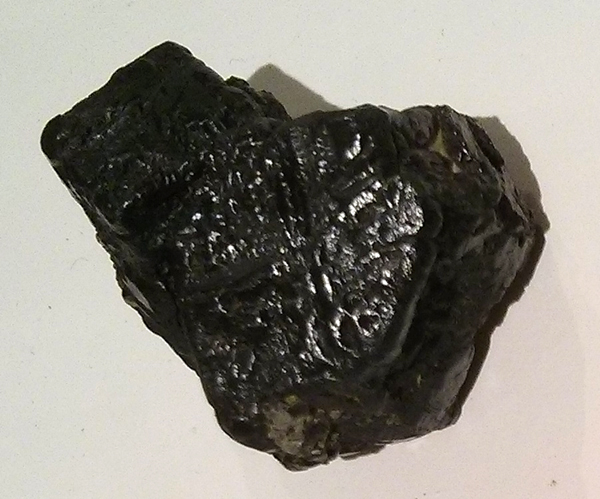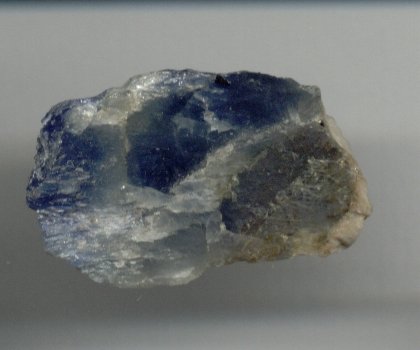|
Titanate
In chemistry, titanate usually refers to inorganic compounds composed of titanium oxides. Together with niobate, titanate salts form the Perovskite group. In some cases, the term is used more generally for any titanium-containing anion, e.g. iCl6sup>2− and i(CO)6sup>2−. This article focuses on the oxides. Many kinds of titanium oxides are known, and some are commercially important. Typically these materials are white, diamagnetic, high-melting, and insoluble in water. They are often prepared at high temperatures, e.g. using tube furnaces, from titanium dioxide. In virtually all cases, titanium achieves octahedral coordination geometry.. Orthotitanates Orthotitanates have the formula M2TiO4, where M is divalent. An example of such a material is magnesium titanate (Mg2TiO4), which adopts the spinel structure. Li2TiO3 is not considered an orthotitanate since it adopts the rock-salt structure and does not feature an identifiable titanium anion. Orthotitanates almost never ... [...More Info...] [...Related Items...] OR: [Wikipedia] [Google] [Baidu] |
Barium Titanate
Barium titanate (BTO) is an inorganic compound with chemical formula BaTiO3. Barium titanate appears white as a powder and is transparent when prepared as large crystals. It is a ferroelectric, pyroelectric, and piezoelectric ceramic material that exhibits the photorefractive effect. It is used in capacitors, electromechanical transducers and nonlinear optics. Structure The solid exists in one of four polymorphs depending on temperature. From high to low temperature, these crystal symmetries of the four polymorphs are cubic, tetragonal, orthorhombic and rhombohedral crystal structure. All of these phases exhibit the ferroelectric effect apart from the cubic phase. The high temperature cubic phase is easiest to describe, as it consists of regular corner-sharing octahedral TiO6 units that define a cube with O vertices and Ti-O-Ti edges. In the cubic phase, Ba2+ is located at the center of the cube, with a nominal coordination number of 12. Lower symmetry phases are stabili ... [...More Info...] [...Related Items...] OR: [Wikipedia] [Google] [Baidu] |
Barium Orthotitanate
Barium orthotitanate is the inorganic compound with the chemical formula Ba2TiO4. It is a colourless solid that is of interest because of its relationship to barium titanate, a useful electroceramic. Structure The solid has two known phases: a low-temperature (β) phase with ''P''21/''n'' symmetry and a high-temperature (α′) phase with ''P''21''nb'' symmetry. The structure of Ba2TiO4 is unusual among the titanates because its titanium atoms sit in a four-oxygen tetrahedron rather than a six-oxygen octahedron. Production It forms as white crystals from a melt of BaCl2, BaCO3 and TiO2 or from just sintering BaCO3 and TiO2. Another method of preparation is heating pellets of Ba(OH)2 and TiO2. Additionally, there are polymer precursor, sol-gel and reverse micellar routes to Ba2TiO4 synthesis. Ba2TiO4 has also been successfully grown as a thin film with chemical vapor deposition. Properties * Room temperature entropy - 47.0 cal/deg. mol * Dielectric constant - 20 ... [...More Info...] [...Related Items...] OR: [Wikipedia] [Google] [Baidu] |
Ferroelectric
Ferroelectricity is a characteristic of certain materials that have a spontaneous electric polarization that can be reversed by the application of an external electric field. All ferroelectrics are also piezoelectric and pyroelectric, with the additional property that their natural electrical polarization is reversible. The term is used in analogy to ferromagnetism, in which a material exhibits a permanent magnetic moment. Ferromagnetism was already known when ferroelectricity was discovered in 1920 in Rochelle salt by Joseph Valasek.See and Thus, the prefix ''ferro'', meaning iron, was used to describe the property despite the fact that most ferroelectric materials do not contain iron. Materials that are both ferroelectric ''and'' ferromagnetic are known as multiferroics. Polarization When most materials are electrically polarized, the polarization induced, ''P'', is almost exactly proportional to the applied external electric field ''E''; so the polarization is a linear ... [...More Info...] [...Related Items...] OR: [Wikipedia] [Google] [Baidu] |
Perovskite (structure)
A perovskite is any material with a crystal structure following the formula ABX3, which was first discovered as the Perovskite, mineral called perovskite, which consists of calcium titanium oxide (CaTiO3). The mineral was first discovered in the Ural Mountains, Ural mountains of Russia by Gustav Rose in 1839 and named after Russian mineralogist L. A. Perovski (1792–1856). 'A' and 'B' are two positively charged ions (i.e. cations), often of very different sizes, and X is a negatively charged ion (an anion, frequently oxide) that bonds to both cations. The 'A' atoms are generally larger than the 'B' atoms. The ideal Cubic crystal system, cubic structure has the B cation in 6-fold coordination, surrounded by an octahedron of anions, and the A cation in 12-fold cuboctahedron, cuboctahedral coordination. Additional perovskite forms may exist where either/both the A and B sites have a configuration of A1x-1A2x and/or B1y-1B2y and the X may deviate from the ideal coordination configu ... [...More Info...] [...Related Items...] OR: [Wikipedia] [Google] [Baidu] |
Titanium Isopropoxide
Titanium isopropoxide, also commonly referred to as titanium tetraisopropoxide or TTIP, is a chemical compound with the formula . This alkoxide of titanium(IV) is used in organic synthesis and materials science. It is a diamagnetic tetrahedral molecule. Titanium isopropoxide is a component of the Sharpless epoxidation, a method for the synthesis of chiral epoxides. The structures of the titanium alkoxides are often complex. Crystalline titanium methoxide is tetrameric with the molecular formula . Alkoxides derived from bulkier alcohols such as isopropyl alcohol aggregate less. Titanium isopropoxide is mainly a monomer in nonpolar solvents. Preparation It is prepared by treating titanium tetrachloride with isopropanol. Hydrogen chloride is formed as a coproduct: : TiCl4 + 4 (CH3)2CHOH → Ti4 + 4 HCl Properties Titanium isopropoxide reacts with water to deposit titanium dioxide: :Ti4 + 2 H2O → TiO2 + 4 (CH3)2CHOH This reaction is employed in the sol-gel synthesis of TiO2- ... [...More Info...] [...Related Items...] OR: [Wikipedia] [Google] [Baidu] |
Bismuth Titanate
Bismuth titanate or bismuth titanium oxide is a solid inorganic compound of bismuth, titanium and oxygen with the chemical formula of Bi12TiO20, Bi 4Ti3O12 or Bi2Ti2O7. Synthesis Bismuth titanate ceramics can be produced by heating a mixture of bismuth and titanium oxides. Bi12TiO20 forms at 730–850 °C, and melts when the temperature is raised above 875 °C, decomposing in the melt to Bi4Ti3O12 and Bi2O3. Millimeter-sized single crystals of Bi12TiO20 can be grown by the Czochralski process, from the molten phase at 880–900 °C. Properties and applications Bismuth titanates exhibit electrooptical effect and photorefractive effect, that is, a reversible change in the refractive index under applied electric field or illumination, respectively. Consequently, they have potential applications in reversible recording media for real-time holography Holography is a technique that enables a wavefront to be recorded and later re-constructed. Holography is best ... [...More Info...] [...Related Items...] OR: [Wikipedia] [Google] [Baidu] |
Calcium Titanate
Calcium titanate is an inorganic compound with the chemical formula Ca Ti O3. As a mineral, it is called perovskite, named after Russian mineralogist, L. A. Perovski (1792-1856). It is a colourless, diamagnetic solid, although the mineral is often coloured owing to impurities. Synthesis CaTiO3 can be prepared by the combination of CaO and TiO2 at temperatures >1300 °C. Sol-gel processes has been used to make a more pure substance, as well as lowering the synthesis temperature. These compounds synthesized are more compressible due to the powders from the sol-gel process as well and bring it closer to its calculated density (~4.04 g/ml). Structure Calcium titanate is obtained as orthorhombic crystals, more specifically perovskite structure. In this motif, the Ti(IV) centers are octahedral and the Ca2+ centers occupy a cage of 12 oxygen centres. Many useful materials adopt related structures, e.g. barium titanate or variations of the structure, e.g. yttrium barium ... [...More Info...] [...Related Items...] OR: [Wikipedia] [Google] [Baidu] |
Chemistry
Chemistry is the scientific study of the properties and behavior of matter. It is a natural science that covers the elements that make up matter to the compounds made of atoms, molecules and ions: their composition, structure, properties, behavior and the changes they undergo during a reaction with other substances. Chemistry also addresses the nature of chemical bonds in chemical compounds. In the scope of its subject, chemistry occupies an intermediate position between physics and biology. It is sometimes called the central science because it provides a foundation for understanding both basic and applied scientific disciplines at a fundamental level. For example, chemistry explains aspects of plant growth ( botany), the formation of igneous rocks ( geology), how atmospheric ozone is formed and how environmental pollutants are degraded ( ecology), the properties of the soil on the moon ( cosmochemistry), how medications work (pharmacology), and how to collect DNA ... [...More Info...] [...Related Items...] OR: [Wikipedia] [Google] [Baidu] |
Corundum
Corundum is a crystalline form of aluminium oxide () typically containing traces of iron, titanium, vanadium and chromium. It is a rock-forming mineral. It is a naturally transparent material, but can have different colors depending on the presence of transition metal impurities in its crystalline structure. Corundum has two primary gem varieties: ruby and sapphire. Rubies are red due to the presence of chromium, and sapphires exhibit a range of colors depending on what transition metal is present. A rare type of sapphire, padparadscha sapphire, is pink-orange. The name "corundum" is derived from the Tamil- Dravidian word ''kurundam'' (ruby-sapphire) (appearing in Sanskrit as ''kuruvinda''). Because of corundum's hardness (pure corundum is defined to have 9.0 on the Mohs scale), it can scratch almost all other minerals. It is commonly used as an abrasive on sandpaper and on large tools used in machining metals, plastics, and wood. Emery, a variety of corundum with no ... [...More Info...] [...Related Items...] OR: [Wikipedia] [Google] [Baidu] |
Close-packing Of Spheres
In geometry, close-packing of equal spheres is a dense arrangement of congruent spheres in an infinite, regular arrangement (or lattice). Carl Friedrich Gauss proved that the highest average density – that is, the greatest fraction of space occupied by spheres – that can be achieved by a lattice packing is :\frac \approx 0.74048. The same packing density can also be achieved by alternate stackings of the same close-packed planes of spheres, including structures that are aperiodic in the stacking direction. The Kepler conjecture states that this is the highest density that can be achieved by any arrangement of spheres, either regular or irregular. This conjecture was proven by T. C. Hales. Highest density is known only for 1, 2, 3, 8, and 24 dimensions. Many crystal structures are based on a close-packing of a single kind of atom, or a close-packing of large ions with smaller ions filling the spaces between them. The cubic and hexagonal arrangements are very close to one ano ... [...More Info...] [...Related Items...] OR: [Wikipedia] [Google] [Baidu] |




